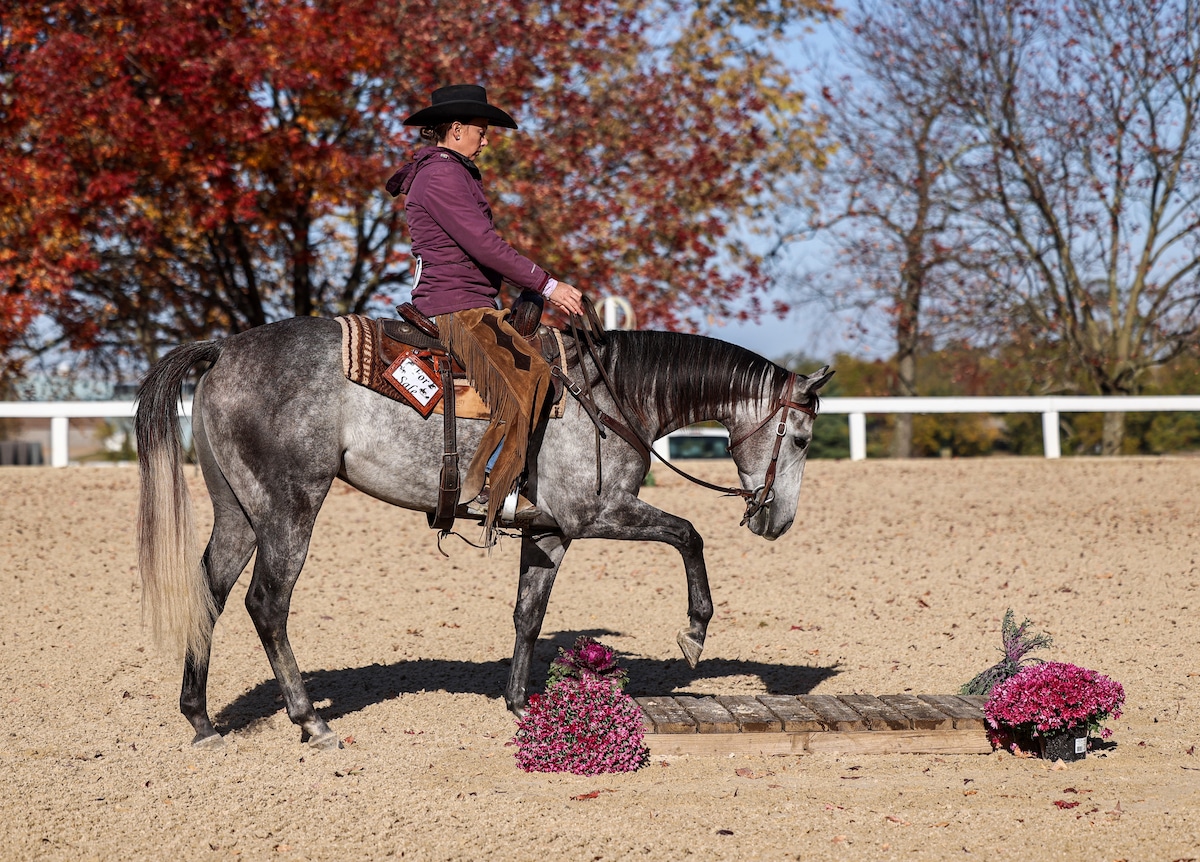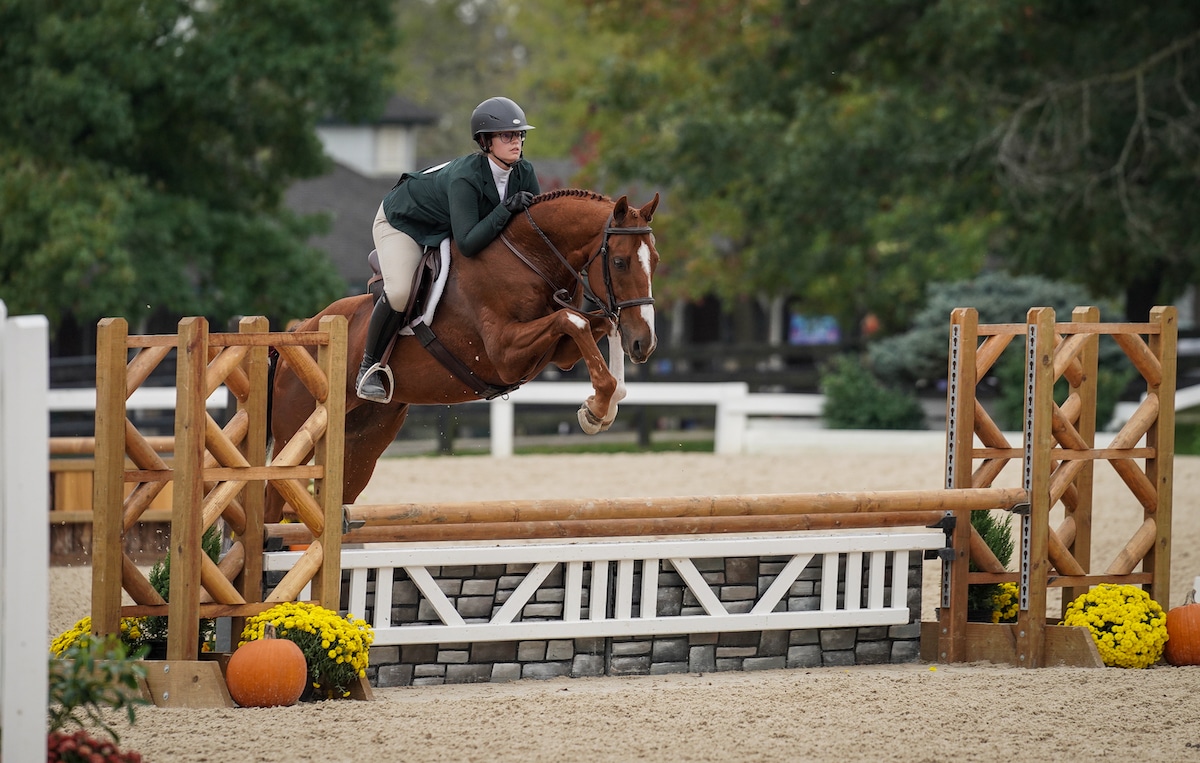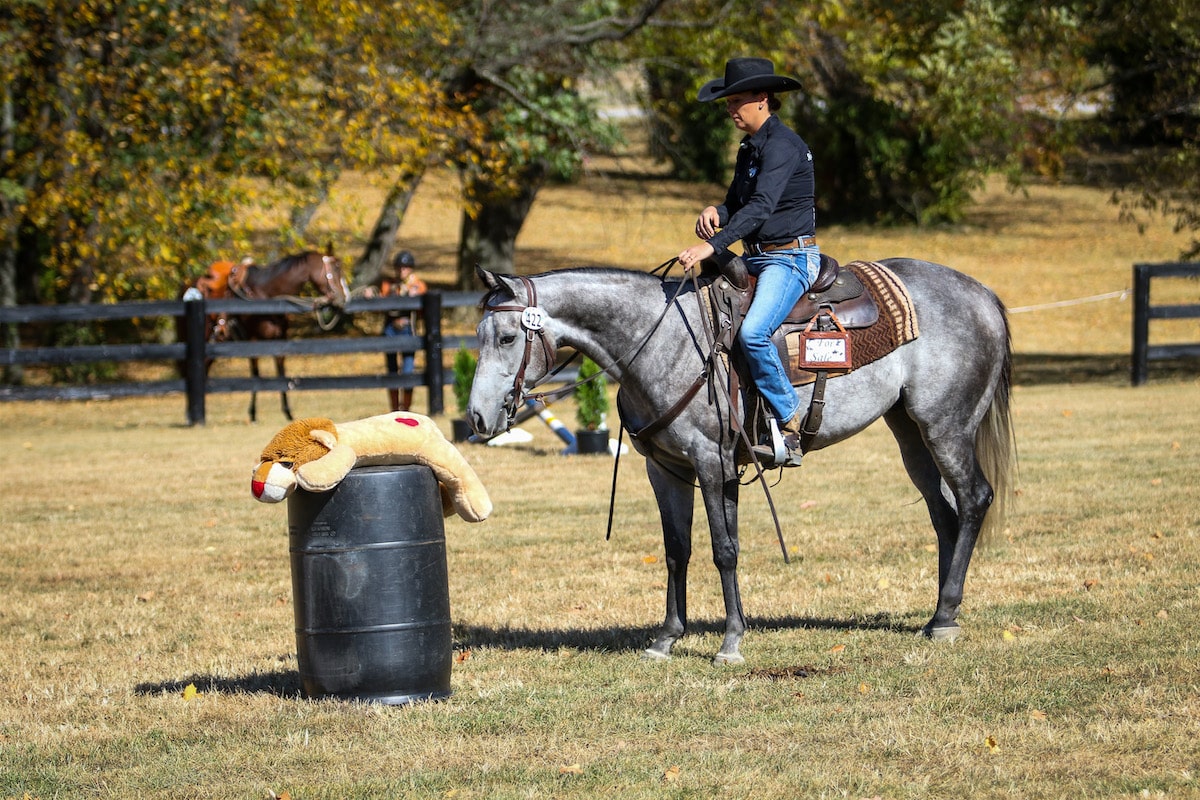
Raechel Ramsey and her 2022 Makeover horse, Stonecatcher. Courtesy CanterClix
It’s a sentiment heard on repeat: Training an off-track Thoroughbred and watching him or her progress is one of the most rewarding experiences an owner and trainer can have. A lot can happen in a very short amount of time with these green, and typically young, horses. Thus, a common question you might have while retraining your OTTB is, “Are we ready to push ahead, or do we need more time, patience and training?” In this article our sources will try to clear up uncertainties about training timelines and how horses are progressing.
Signs of Progress
Trainers who have worked with many OTTBs have learned to recognize the signs a horse is ready to move on to the next level or training “ask.”
“In my discipline of hunter/jumpers, I usually determine readiness based on the horse’s ability to relax down into the bridle and be accepting of aids,” says Rae Lallier, an experienced Thoroughbred Makeover trainer and competitor who’s based in Moorestown, New Jersey. “Once this happens, they’re usually ready to begin over small jumps. I start all of my horses over ground rails at the trot and canter, then advance to cavalettis. I find working on striding between ground rails really helps them learn where to put their feet. Once they can do this, they’re usually ready to move on to larger jumps.”
Raechel Ramsey, a multidiscipline trainer from Nevada, Texas, with several Thoroughbred Makeover competitions under her belt, says her key indicators a horse is ready to push ahead in training are consistency and relaxation. “Can I get on my horse and walk or trot around the arena quietly? Does he consistently respond to my cues? If yes, then I can start layering in a little more training. Even as I add in more, it’s consistently going back to what he knows and is comfortable with, stretching him by asking something new, then right back to what he already knows.”
Another question OTTB trainers might ponder: “Is my horse ready to attend a show?”
“I think you can gauge whether your horse is ready to show or move up a level … by making sure that they can do the minimum requirements of the show or level at home in a safe environment,” says Ramsey. “When they can be consistent at home, then you can introduce some varying distractions in the home environment. Maybe it’s kids running around, or maybe it’s tarps flapping on the rail, and then see if you can still keep their focus on you.”
A horse that’s no longer reactive to sights, sounds and activities at home is usually ready for an off-property outing. “I try to make it the best experience possible by trailering them with a friend, going to another farm or very small horse show, utilizing a calming paste or supplement and always going with an open mind,” says Lallier.
Because OTTBs have trained, raced and been exposed to many things in their past at the track, they are typically not super spooky but, rather, reactive to all the action and stimuli of the horse show atmosphere. “My goal is to instill calm in them for their off-property outings,” she adds. “If it doesn’t go well, be patient and try something else, and know that the more they do it, the better they’ll get.”
Ramsey says she views each show or outing as another opportunity to train. “So, I’m getting there early, and I’m making sure that they have lots of time to walk around the warm-up arena,” she says. “I may even just enter them in a walk-trot class until I know that they can handle the environment. There have been a few times where I’ve taken a horse in a rail class, and he could not keep it together. I simply got off the horse and led him out of the arena at that point. We stood in the corner and watched the class, however, and by the end of the day he was able to step into the arena with 15 other horses and remembered his training. The key is just to up the threshold level a little bit every time while still maintaining their attention.”
Preparing for the Thoroughbred Makeover

In her discipline of hunter/jumpers, Rae Lallier (pictured here on her 2021 Makeover horse, Stolen Love) says she determines readiness based on a horse’s ability to relax into the bridle and be accepting of aids. Courtesy CanterClix
The Thoroughbred Makeover is a goal some trainers have from the moment they purchase their OTTBs. Even when trainers put extensive training into their horses and take lots of trips away from home and to shows, the Makeover is a difficult experience to duplicate. It takes place at the Kentucky Horse Park, a large venue with hundreds of horses competing and multiple disciplines running concurrently — an atmosphere that can be electric for some horses.
“Last year was the first year I had a horse that I truly questioned his readiness for the (jumping) disciplines we had planned for him,” Lallier says. “Although we took this horse on many outings to get him off the property, he was often very tense and stressed. Although it was a new discipline for his owner, we instead began doing some dressage. He seemed less stressed when we removed jumping from the equation, and he successfully competed in Dressage and Freestyle (at the Makeover).
“I think as long as you are willing to put the time into taking your horse to off-property and, preferably, overnight outings, there are enough disciplines at the Makeover to be able to pivot to something new if need be.”
Exposing green OTTBs to as many environments as possible is invaluable not only in preparation for the Makeover but also for their overall development and confidence. “I haul to the cow-sorting practice even if I’m not working cows so they’re around the cattle environment,” says Ramsey. “I haul to the barrel racing and just ride in the warm-up pen. I haul to the hunter/jumper shows, I haul to obstacle practices or just anything that you can think of that puts them in a new and strange environment that is going to teach them coping methods.”
She says another key to making sure a horse is ready for the Makeover is identifying their biggest weakness or hurdle and focusing on it (in gradual doses, of course, without flooding or stressing the horse) until it’s no longer an issue.
“So, if they have issues riding in an open field for example, then that’s your goal for 30 days straight (in a safe way),” Ramsey says. “Or, if they have issues in a big environment with lots of other horses riding around them, then set yourself up to get them exposed to that. Really desensitizing and teaching the horse coping methods for when they reach a threshold level is key to setting yourself up for success.”
When To Hit Pause
Sometimes it’s not about looking for the signs a horse is ready to show or move up a level, it’s about recognizing when to slow down or take things back a step. For Lallier, the biggest indicator is resistance to the aids.
“Frequently for Thoroughbreds, it’s that they are strong and often run through the rider’s hand,” she says. “However, I have also had the opposite issue of the horse not being prompt to move off my leg and go forward. This is also a sign that you need to step back, because pushing a horse to jump bigger or perform more difficult flatwork without impulsion from the hind end and a willingness to move off the leg definitely creates an issue down the road.” (Not wanting to move forward off the leg can also be a sign of pain, so be sure you consult a veterinarian if the behavior does not subside with adjustments to training.)
“Reactive horses also need more time with the basics and often a lot of ground work and confidence,” Lallier adds. “I find most Thoroughbreds aren’t ‘spooky,’ but they are skeptical, and if you are more confident on the ground than you are in the tack, then help them through those new experiences on the ground first.”
Other signs of lack of progress include stress-related behaviors such as chewing on the bit, head-tossing, kicking out, excessive sweating or spooking, which can indicate the horse is over his learning and training threshold, says Ramsey. “It’s not going to stick, because he’s more worried about something else than what we’re learning,” she says. “So then we back up to something he’s familiar and comfortable with again,” before asking for the next step or presenting a new challenge.
Putting in the Time and Effort

When working with a green OTTB, Raechel Ramsey identifies their biggest weakness or hurdle and focuses on it until it’s no longer an issue. Courtesy CanterClix
A unanimous piece of advice from our sources is to get horses off property and into new environments as frequently as is safely and realistically possible, and be prepared for the unexpected.
“Hauling and exposing them to as many different things as possible in a positive way — that is what ultimately builds their confidence,” Ramsey says.
“One other thing I would want someone to keep in mind is that properly preparing a horse for a big competition like the Makeover is time-consuming, and it can be expensive,” Lallier adds. “Make sure to budget and plan outings accordingly, and make sure you have cushion for unexpected bumps in the road as it relates to veterinary care or extra outings.
“In the past, I’ve had horses that needed (joint) injections, ulcer treatments, corrective shoeing and more off-property time than I may have needed with another horse,” she adds. “But, if you take the time, these horses are well worth it! My 2018 Makeover horse is enjoying his career in the Take2 hunters and currently doing first-level dressage. It’s all about the journey.”

